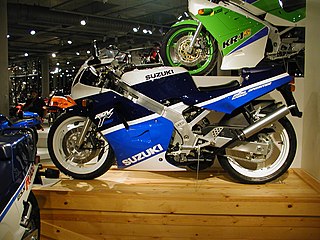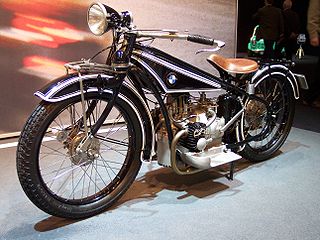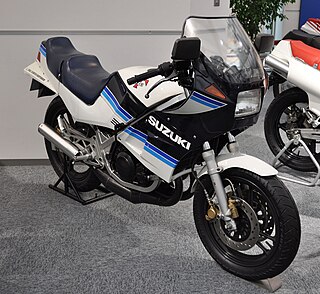
Grand Prix motorcycle racing is the premier class of motorcycle road racing events held on road circuits sanctioned by the Fédération Internationale de Motocyclisme (FIM). Independent motorcycle racing events have been held since the start of the twentieth century and large national events were often given the title Grand Prix. The foundation of the Fédération Internationale de Motocyclisme as the international governing body for motorcycle sport in 1949 provided the opportunity to coordinate rules and regulations in order that selected events could count towards official World Championships. It is the oldest established motorsport world championship.

A straight-three engine is a three-cylinder piston engine where cylinders are arranged in a line along a common crankshaft.

Suzuki Motor Corporation is a Japanese multinational corporation headquartered in Minami-ku, Hamamatsu, Japan. Suzuki manufactures automobiles, motorcycles, all-terrain vehicles (ATVs), outboard marine engines, wheelchairs and a variety of other small internal combustion engines. In 2016, Suzuki was the eleventh biggest automaker by production worldwide. Suzuki has over 45,000 employees and has 35 production facilities in 23 countries, and 133 distributors in 192 countries. The worldwide sales volume of automobiles is the world's tenth largest, while domestic sales volume is the third largest in the country.

A U engine is a piston engine made up of two separate straight engines placed side-by-side and coupled to a shared output shaft. When viewed from the front, the engine block resembles the letter "U".

Universal Japanese Motorcycle (UJM) is a term for Japanese standard motorcycles coined in the 1970s. It referred to motorcycles made by Japanese manufacturers that made motorcycles more accessible to common people. It commonly refers to Japanese motorcycles made for commuting with a four-stroke and inline four-cylinder engine. By around 1990 its popularity began to wane as the market fragmented into more specialized designs.

The Suzuki RG150 was a 148 cc two-stroke racing motorcycle produced by Suzuki in Thailand. The bike was produced from 1996 until 2000. In 1998, it was selected as the second-best new motorcycle of 1998 by Motor Trend magazine.
The GSX Series is Suzuki's range of sport touring motorcycles powered by four-valve per cylinder four-stroke engines. The first GSX models were introduced in 1980 and represented the next step in Suzuki's four-stroke road bike range after the two-valve GS Series.

A sport bike is a motorcycle designed and optimized for speed, acceleration, braking, and cornering on asphalt concrete race tracks and roads. They are mainly designed for performance at the expense of comfort, fuel economy, and storage in comparison with other motorcycles.

The Suzuki RGV250 was a Suzuki high performance sport bike which had a great number of its features and design cues based on Grand Prix technologies and ideas. It is a race-replica based on Suzuki's 250 cc (15 cu in) GP bikes from 1987 to 1998, the RGV V-2 racer. This motorcycle replaced the RG250 Gamma, which employed an alloy frame with a two-stroke parallel twin engine. The bike produced over 60 bhp in a narrow power band between 8,000 and 11,000 rpm. The dry weight ranged between 128 kg (282 lb) (1989) to 140 kg (309 lb) dry weight.

The BMW R32 was the first motorcycle produced by BMW under the BMW name. An aircraft engine manufacturer during World War I, BMW was forced to diversify after the Treaty of Versailles banned the German air force and German aircraft manufacture. BMW initially turned to industrial engine design and manufacturing.

The Kawasaki triples were a range of 250 to 750 cc motorcycles made by Kawasaki from 1968 to 1980. The engines were air-cooled, three-cylinder, piston-controlled inlet port two-strokes with two exhaust pipes exiting on the right side of the bike, and one on the left. It was the first production street motorcycle with capacitor discharge ignition (CDI). Right from the first triple model, the 1968 Mach III H1 500 cc, it was a sales success that gained a reputation for almost unmatched acceleration as well as an air of danger for inexperienced riders trying to cope with the bike's increased power to weight ratio over any previously available stock motorcycles.

The Suzuki RG250 Gamma was a two-cylinder parallel, water-cooled 250 cc two-stroke motorcycle produced by Suzuki from 1983 to 1987. One of the major features of the RG250 Gamma was its large power-to-weight ratio. Able to produce up to 45+ BHP at 8,500 RPM and 38.4 Nm torque at 8,000 RPM, weighing in at roughly 130 kg. The RG250 Gamma was the first mass-produced motorcycle to have a lightweight aluminum frame and racing type aerodynamic fairing. The Gamma also had a very advanced 'full floater' suspension system for its time, with the first Mk1s having 'anti-dive' front forks. Due to this, the bike was dubbed the first street legal racer.

Suzuki MotoGP was the factory-backed team of Japanese motorcycle manufacturer Suzuki in the MotoGP World Championship, most recently using the name Team Suzuki Ecstar for sponsorship purposes. Suzuki withdrew from MotoGP competition at the conclusion of the 2022 season, winning their final race with Álex Rins.

The Suzuki Intruder is a series of cruiser motorcycles made by Suzuki from 1985 to 2005. After 2005, the Intruder lineup was replaced by the Boulevard range. In Europe, the Intruder name remains in use on certain models. The VS Intruder bikes all have 4-stroke V-twin engines.
Suzuki RG 500 gamma racing motorcycle was manufactured by Suzuki from 1981 to 1984 for competition in the Grand Prix motorcycle racing series. The motorcycle was powered by a 500 cc two stroke engine.

The Suzuki GSX-R1100 is a sport bike from Suzuki's GSX-R series of motorcycles produced from 1986 until 1998.
Piero Remor was an Italian engineer and motorcycle constructor, best known for his work for the Gilera and MV Agusta brands.

The Suzuki GT250, also known as the Suzuki Hustler in the US is a 247 cc (15.1 cu in), two-stroke, twin-cylinder motorcycle produced by the Japanese Suzuki company between 1971 and 1981. The model was developed from the earlier T250, and was one of the best selling motorcycles in its class. For 1978 the bike was redesign and marketed as the GT250 X7. The X7 was capable of reaching 100 mph (160 km/h) in favourable conditions. The model range was discontinued in 1981 in favour of Suzuki's four stroke models, and the X7 was developed into the RG250 Gamma.

The Suzuki T350, also known as the Suzuki Rebel is a 315 cc (19.2 cu in), two-stroke, twin-cylinder motorcycle produced by the Japanese Suzuki company between 1969 and 1972. The model was based T305 and used an enlarged version of the T305 engine, which itself was an enlargement of the T20 unit. It was the fastest production 350 at the time. In 1972 a T350 was overall winner of the Australian Castrol Six Hour Production race at Amaroo Park but was subsequently disqualified but the same bike won the 500cc class in 1973. The model was dropped when the T380 triple was introduced in 1972.

The Suzuki T500, variously known as the Suzuki T500/Five, Suzuki Charger, Suzuki Cobra and the Suzuki Titan during its model life, is a 492 cc (30.0 cu in), two-stroke, twin-cylinder motorcycle produced by the Japanese Suzuki company between 1968 and 1975. The model was developed as a larger version of the Suzuki T20 which was intended to compete with the large-capacity British twins in the American market. When introduced it was Suzuki's largest displacement machine. Overengineering of the engine led to the bike gaining a reputation for reliability, and being virtually bulletproof. A total of over 100,000 units were sold during the model's production.

















